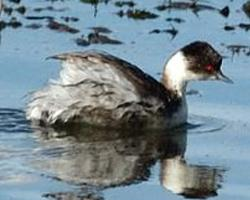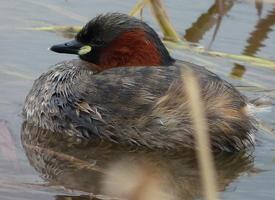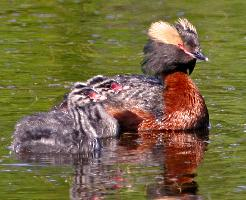
Starea de conservare
| Amenințat |
Descrierea animalului
The Silvery Grebe, scientifically known as Podiceps occipitalis, is a fascinating bird species that belongs to the Podicipedidae family, which encompasses the world's grebes. This particular species is distinguished by its unique appearance and behaviors, captivating bird watchers and nature enthusiasts alike.Physical Description:
The Silvery Grebe is a medium-sized bird, with adults typically reaching lengths of about 28 to 34 cm (11 to 13 inches) and weighing approximately 250 to 450 grams (8.8 to 15.9 ounces). Its slender, elongated neck and sharp, pointed bill are characteristic features of the species. The bird's plumage is a striking mix of colors and patterns. During the breeding season, adults boast a distinctive silvery-grey color on their back and wings, which contrasts beautifully with their white underparts. The head is adorned with a black cap that extends to just below the eye, and a conspicuous white patch can be seen on the sides of the face, behind the eye, giving it its name 'occipitalis' which means 'of the back of the head'. The eyes are a vivid red, adding a splash of color to its otherwise muted tones.
Habitat and Distribution:
The Silvery Grebe is found across a wide range of South America, from the southern parts of Colombia and Venezuela all the way down to the southern tip of the continent in Tierra del Fuego. It inhabits freshwater lakes, marshes, and occasionally sheltered coastal lagoons, showing a preference for high-altitude Andean lakes. The bird's distribution is somewhat patchy, with populations thriving in areas that offer abundant aquatic vegetation and clear, unpolluted waters.
Behavior and Diet:
Silvery Grebes are excellent swimmers and divers, using these skills to forage for food. Their diet primarily consists of small fish, aquatic insects, and a variety of invertebrates. They have been observed diving for several seconds, covering considerable distances underwater in pursuit of prey. During the breeding season, these grebes become highly territorial and vocal, using a series of calls and displays to communicate with each other and ward off intruders.
Reproduction:
The breeding season of the Silvery Grebe varies depending on its geographic location but generally occurs during the warmer months. They are monogamous birds, forming long-lasting pairs. Nests are built on floating vegetation, anchored to underwater plants, providing a safe platform for the eggs. Females typically lay between 3 to 4 eggs, which are incubated by both parents for about 21 days. Chicks are precocial, meaning they are relatively mature and mobile from the moment of hatching. They are cared for by both parents and are often seen riding on the backs of their parents as they swim.
Conservation Status:
The Silvery Grebe is currently listed as Least Concern by the International Union for Conservation of Nature (IUCN), indicating that it is not at immediate risk of extinction. However, like many species, it faces threats from habitat destruction, pollution, and climate change, which could impact its populations in the future. Conservation efforts focused on preserving its natural habitats and monitoring population trends are crucial to ensure the long-term survival of this remarkable bird.
In conclusion, the Silvery Grebe is a captivating species with its elegant appearance, intriguing behaviors, and fascinating life cycle. It is a testament to the diversity and complexity of the natural world, reminding us of the importance of conservation efforts to protect such unique species and their habitats.
Animale similare
Fotografii noi cu animale
Top 10 animale
- Diana monkey (Cercopithecus diana)
- Dolphin gull (Leucophaeus scoresbii)
- Galápagos tortoise (Geochelone nigra complex)
- Moustached guenon (Cercopithecus cephus)
- Japanese spider crab (Macrocheira kaempferi)
- Colossal squid (Mesonychoteuthis hamiltoni)
- Fox tapeworm (Echinococcus multilocularis)
- Stone loach (Barbatula barbatula)
- Japanese macaque (Macaca fuscata)
- Barbary macaque (Macaca sylvanus)


